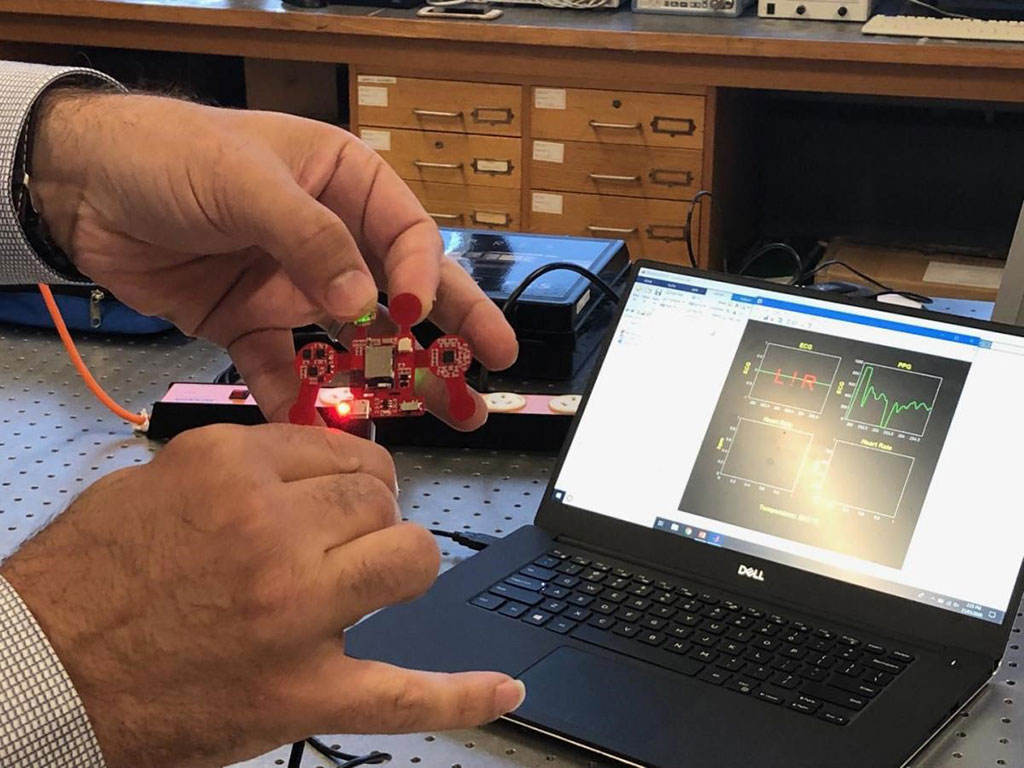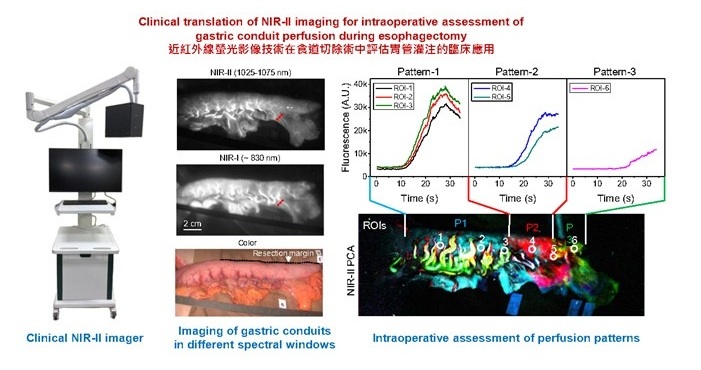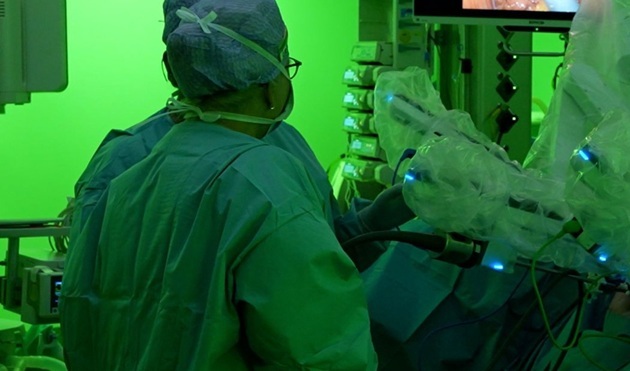Wearable Radar Sensor Measures Blood Pressure Continuously 
|
By HospiMedica International staff writers Posted on 26 Feb 2020 |

Image: The CWR sensor that attaches to the sternum (Photo courtesy of Monash University)
A new study describes how two clip-on sensors attached to the sternum and earlobe can provide real-time blood pressure results.
Under development at Monash University (Melbourne, Australia), the novel measurement technique is based on radar sensor methodology. Instead of the traditional arm cuff, it uses a small continuous wave radar (CWR) sensor adhered to the sternum, and a photoplethysmogram sensor (PPG) clipped to the left earlobe. Using both sensors, the system measures pulse arrival time (PAT), pre-ejection period (PEP), and pulse transit time (PTT), and calculate continuous systolic blood pressure (SBP) from the data.
The researchers then collected experimental data from 43 subjects (40-65 years of age) in various static postures, as well as in 26 subjects doing six different exercise tasks, such as cycling on a stationary bike. Two mathematical models were then used to calculate SBP from the PTT/PAT data, and compare then to simultaneous sphygmomanometer readings. The results showed that for participants in the posture tasks, the best cumulative error percentage (CEP) was 92.28%, and for those in the exercises group, the best CEP was 82.61%. Additionally, removing PEP from PAT lead to a 9% improvement in results. The study was published on November 27, 2019, in Nature Scientific Reports.
“Clinicians still cannot continuously measure blood pressure during sleep, nor during times of activity such as walking or running. This means people with high, low, or irregular blood pressure can’t get the critical information they need about the state of their health around the clock,” said senior author Mehmet Yuce, PhD, of the department of electrical and computer systems engineering. “A wearable device that can provide comfort and portability while people are going about their daily lives will be a significant development for the health sector in Australia and internationally.”
CWR uses known radiofrequency (RF) energy that is transmitted and then received from any reflecting objects. Any movement of the transmitter, target, or both causes a change in the frequency of the electromagnetic wave, known as the Doppler shift. It is also possible to use CWR to measure range instead of range rate by frequency modulation. By measuring the frequency of the return signal, the time delay between transmission and reception can be measured.
Related Links:
Monash University
Under development at Monash University (Melbourne, Australia), the novel measurement technique is based on radar sensor methodology. Instead of the traditional arm cuff, it uses a small continuous wave radar (CWR) sensor adhered to the sternum, and a photoplethysmogram sensor (PPG) clipped to the left earlobe. Using both sensors, the system measures pulse arrival time (PAT), pre-ejection period (PEP), and pulse transit time (PTT), and calculate continuous systolic blood pressure (SBP) from the data.
The researchers then collected experimental data from 43 subjects (40-65 years of age) in various static postures, as well as in 26 subjects doing six different exercise tasks, such as cycling on a stationary bike. Two mathematical models were then used to calculate SBP from the PTT/PAT data, and compare then to simultaneous sphygmomanometer readings. The results showed that for participants in the posture tasks, the best cumulative error percentage (CEP) was 92.28%, and for those in the exercises group, the best CEP was 82.61%. Additionally, removing PEP from PAT lead to a 9% improvement in results. The study was published on November 27, 2019, in Nature Scientific Reports.
“Clinicians still cannot continuously measure blood pressure during sleep, nor during times of activity such as walking or running. This means people with high, low, or irregular blood pressure can’t get the critical information they need about the state of their health around the clock,” said senior author Mehmet Yuce, PhD, of the department of electrical and computer systems engineering. “A wearable device that can provide comfort and portability while people are going about their daily lives will be a significant development for the health sector in Australia and internationally.”
CWR uses known radiofrequency (RF) energy that is transmitted and then received from any reflecting objects. Any movement of the transmitter, target, or both causes a change in the frequency of the electromagnetic wave, known as the Doppler shift. It is also possible to use CWR to measure range instead of range rate by frequency modulation. By measuring the frequency of the return signal, the time delay between transmission and reception can be measured.
Related Links:
Monash University
Latest Critical Care News
- AI-Enhanced Wearables Could Transform Type 2 Diabetes and Prediabetes Care
- Breathable Electronic Skin Paves Way for Next-Generation Wearable Devices
- AI Transforming Colon Cancer Diagnosis
- Ventricular Assist Device Offers Long-Term Use in Children Waiting for Donor Heart
- Precision Approach Improves Immunotherapy Effectiveness for ICU Patients with Sepsis
- Soft Robots Could Donate Their Heart to Humans
- Bioadhesive Strategy Prevents Fibrosis Around Device Implants on Peripheral Nerves
- Miniature Non-Invasive Robotic Catheters to Improve Infertility Treatments
- Stick-On Patch Monitors Baby's Movements In Utero
- EEG-Based AI Technology Accurately Diagnoses Alzheimer’s and Dementia
- Robot Lymphatic System Paves Way for Self-Powered Wearables and Machines
- Focused Ultrasound Technique Successfully Treats Pediatric Brain Cancer
- Nasal Drops Fight Brain Tumors Noninvasively
- AI Helps Optimize Therapy Selection and Dosing for Septic Shock
- Glowing Bacteria ‘Pills’ for Detecting Gut Diseases Could Eliminate Colonoscopies
- Skin-Permeable Polymer Patch Delivers Insulin Non-Invasively Through Skin
Channels
Surgical Techniques
view channel
3D-Printed Blood Vessel Scaffolds Could Transform Heart Bypass Surgeries
A tiny, opaque tube held up in a lab may look unremarkable at first glance, but its microscopic surface features could mark a meaningful step forward in heart bypass surgery. Measuring just about one centimeter... Read more
Novel Imaging Technique Helps View Blood Perfusion During Esophageal Surgery
Esophagectomy is a complex and high-risk surgery often required for esophageal cancer, with anastomotic leakage remaining one of its most serious complications. This defect at the surgical suture line... Read more
Minimally Invasive Surgery Proven Safe and Effective for Complex ‘Whipple’ Procedure
Tumors of the pancreatic head often require a highly complex operation known as pancreatoduodenectomy or the Whipple procedure. This surgery involves removing multiple structures and creating several internal... Read more
Catheter-Based Procedures Offer Less Invasive Option for Treatment of Valvular Disease
Valvular heart disease, caused by tight or leaky valves between heart chambers, affects up to 10% of older adults and leads to more than 120,000 deaths globally each year. Traditional open-heart surgery... Read morePatient Care
view channel
Revolutionary Automatic IV-Line Flushing Device to Enhance Infusion Care
More than 80% of in-hospital patients receive intravenous (IV) therapy. Every dose of IV medicine delivered in a small volume (<250 mL) infusion bag should be followed by subsequent flushing to ensure... Read more
VR Training Tool Combats Contamination of Portable Medical Equipment
Healthcare-associated infections (HAIs) impact one in every 31 patients, cause nearly 100,000 deaths each year, and cost USD 28.4 billion in direct medical expenses. Notably, up to 75% of these infections... Read more
Portable Biosensor Platform to Reduce Hospital-Acquired Infections
Approximately 4 million patients in the European Union acquire healthcare-associated infections (HAIs) or nosocomial infections each year, with around 37,000 deaths directly resulting from these infections,... Read moreFirst-Of-Its-Kind Portable Germicidal Light Technology Disinfects High-Touch Clinical Surfaces in Seconds
Reducing healthcare-acquired infections (HAIs) remains a pressing issue within global healthcare systems. In the United States alone, 1.7 million patients contract HAIs annually, leading to approximately... Read moreHealth IT
view channel
EMR-Based Tool Predicts Graft Failure After Kidney Transplant
Kidney transplantation offers patients with end-stage kidney disease longer survival and better quality of life than dialysis, yet graft failure remains a major challenge. Although a successful transplant... Read more
Printable Molecule-Selective Nanoparticles Enable Mass Production of Wearable Biosensors
The future of medicine is likely to focus on the personalization of healthcare—understanding exactly what an individual requires and delivering the appropriate combination of nutrients, metabolites, and... Read moreBusiness
view channel
Philips and Masimo Partner to Advance Patient Monitoring Measurement Technologies
Royal Philips (Amsterdam, Netherlands) and Masimo (Irvine, California, USA) have renewed their multi-year strategic collaboration, combining Philips’ expertise in patient monitoring with Masimo’s noninvasive... Read more
B. Braun Acquires Digital Microsurgery Company True Digital Surgery
The high-end microsurgery market in neurosurgery, spine, and ENT is undergoing a significant transformation. Traditional analog microscopes are giving way to digital exoscopes, which provide improved visualization,... Read more
CMEF 2025 to Promote Holistic and High-Quality Development of Medical and Health Industry
The 92nd China International Medical Equipment Fair (CMEF 2025) Autumn Exhibition is scheduled to be held from September 26 to 29 at the China Import and Export Fair Complex (Canton Fair Complex) in Guangzhou.... Read more









.jpg)



